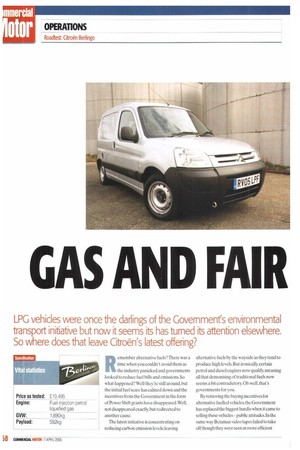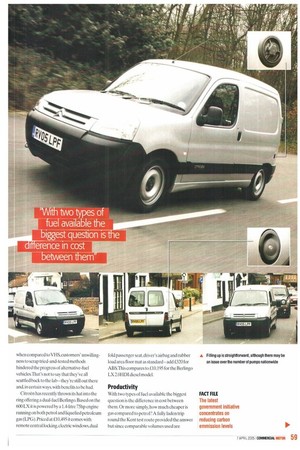GAS AND FA
Page 58

Page 59

Page 60

Page 61

If you've noticed an error in this article please click here to report it so we can fix it.
LPG vehicles were once the darlings of the Government's environmental transport initiative but now it seems its has turned its attention elsewhere.
So where does that leave Citroen's latest offering?
Remember alternative fuels? There was a time when you couldn't avoid them as the industry panicked and governments looked to reduce fuel bills and emissions. So what happened? Well they're still around, but the initial fuel scare has calmed down and the incentives from the Government in the form of Power Shift grants have disappeared.Well, not disappeared exactly but redirected to another cause.
The latest initiative is concentrating on reducing carbon emission le vels,leaving alternative fuels by the wayside as they tend to produce high levels. But ironicaLly,certain petrol and diesel engines now qualify, meaning all that demonising of traditional fuels now seems a bit contradictory. Oh well, that's governments for you.
By removing the buying incentives for alternative fuelled vehicles, the Government has replaced the biggest hurdle when it came to selling these vehicles public attitudes. In the same way Betamax video tapes failed to take off though they were seen as more efficient when compared to VHS, customers' unwillingness to scrap tried-and-tested methods hindered the progress of alternative-fuel vehicles:That's not to say that they've all scuttled back to the lab — they're still out there and, in certain ways, with benefits lobe had.
Citroen has recently thrown its hat into the ring offering a dual-fuel Berlingo. Based on the 600 LX it is powered by a 1.4-litre 75hp engine running on both petrol and liquefied petroleum gas (LPG), Priced at £10,495 it comes with remote central locking, electric windows. dual fold passenger seat, driver's airbag and rubber load area floor mat as standard— add £.320 for ABS.This compares to £l0, 95 for the Berlingo LX 2.0HD1 diesel model.
Productivity
With two types of fuel available the biggest question is the difference in cost between them. Or more simply, how much cheaper is gas compared to petrol? A fully laden trip round the Kent test route provided the answer but since comparable volumes used are irrelevant it's best displayed in monetary terms:19.35 of petrol was required, compared with only £5.87 for LPG. For comparison the Berlingo2.0HDI works out at £7.70 (CM 23 January 03).The Berlingo comes with a 60-litre petrol tank and a 36-litre LPG tank which is claimed to be good for about 250 miles.
With its high-cube set up, the Berlingo's load area can be fully exploited and a load-volume of 3.0m means there's a competitive amount of space to be used—this is unaffected by the extra engineering of the dual-fuel setup. Our version didn't come with the optional sliding door, but loading up was assisted by low lip rear doors that opened out 180°,though they could lock out more securely under windy conditions.The LX also comes with a multi-function passenger seat which can be folded down into a handy worktable or folded completely forward for more space.
Filling up is not an issue as long as you follow the instructions, but attention should be paid to ensure a proper lock is created on connection between pump and vehicle. What may be an issue is the amount of pumps available around the country, especially since the vehicle's range is considerably shorter than traditional fuelled equivalents. Switching between the two only requires the pushing of a button mounted centrally on the dashboard.
One other factor worth considering is its exemption from the congestion charge. If entering on a regular basis this could lead to a substantial saving.The downside with such a specific vehicle is that its residual value is lower compared to the diesel equivalent.After three years based on 50,000km per year CAP values it at £1250 compared to £1,775 for the equivalent 2.0HDI. Mark Norrnan,managing editor for CAP Monitor, says: "The combination of petrol and LPG for a dual-fuel vehicle is not a good one when it comes to the secondhand market — diesel is far too competitive a fuel when compared to this set up."
Though it may be mechanically different from the rest of the range, the warranty comes with the same 100,000 miles/three years cover.
On the road
It may be in the same class as the Transit Connect, but the Berlingo is a light-weight machine —2,200kg v 1,690kg respectively.This is no bad thing for several reasons with the main being fuel econorny,but it also makes the van feel more manoeuvrable around town. Steering is also light, with a high ratio allowing quick turning in tight circles. But this is counteracted by an engine that noticeably lacks a degree of low down torque. This is not surprising as being a petrol-based unit it would rather spin through the rev range — which it does smoothly enough— until you get it to peak torque near the top.A full payload will be a noticeable burden.
As for the difference in performance between the two fuels, this is negligible: 0-50mph took 14.3 seconds for petrol while LPG was just slightly slower at 14.7.
Through the corners it grips surprisingly well, gripping the asphalt right to the limit and if you are reckless enough it scrubs off speed and allows you to ease off and bring it back into line. Its chassis is also compliant,absorbing most bumps and undulations in its stride.
On the open road its "light" characteristics become a bit more negative. That light steering makes it a touch fidgety on motorways and though the chassis is competent at high speeds it doesn't feel as well planted as heavier alternatives from VW and Ford.
Cab comfort
You're never going to be overwhelmed by the Berlingo's interior but it's functional enough to raise few complaints.The overall colour scheme is black and grey. but tastefully done — the quality of plastics used and the overall fitment is good.
The driver's seat is firm but comfortable though leg room is limited and the steering wheel is only adjustable for rake.
This does not detract too much from attaining a decent driving position and this is helped by the location of all the major controls, which are close to hand and easy to operate. Visibility is good with the large windscreen allowing plenty of light in. and storage is well thought out with door bins, cubby holes and a central compartment and tray.Also working to the Berlingo's credit is the lack of road roar considering there's no bulkhead, it cruises without a fuss. •
















































































































































































































